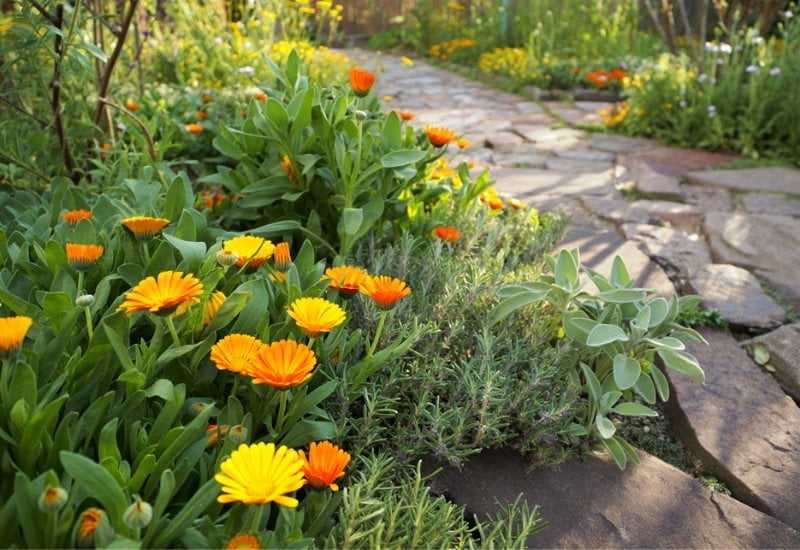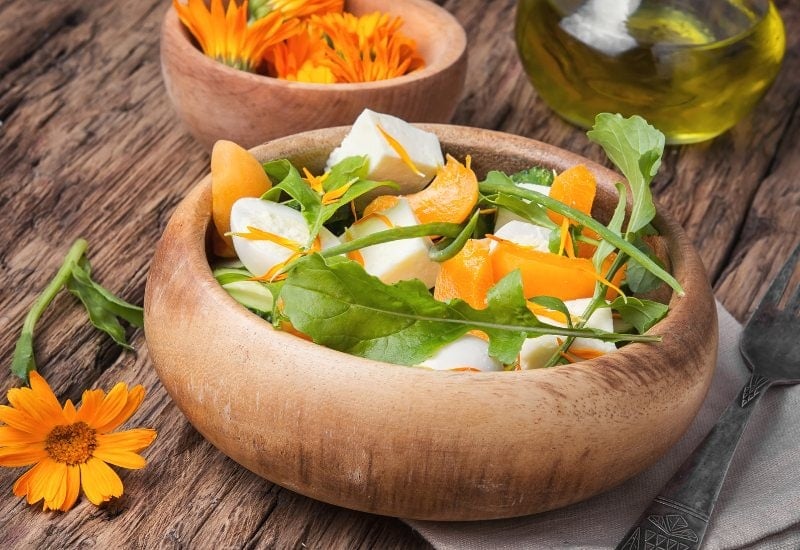
Calendula is not just a charming daisy-like flower. You have a lot of reasons to grow it! It’s great for your garden’s beauty – and health! And for yours as well, because it has medicinal properties. But you can use it in your kitchen as well, because its vibrant yellow to orange, and romantic creams to pink blossoms are fully edible, and they can add rare nutrients to your food – as well as a touch of color!
You may already grow calendula in your garden, and wonder what you can do with this generous blooming plant – or maybe you are wondering why you should start keeping it in your flower bed (or veggie garden, if you wish)?
Then, let me answer all your questions here!
Reason to Grow Calendula Nr 1 – It Is Easy to Grow and Adaptable, But VERY Generous Indeed!

To start with, you should be growing calendulas in your garden because it’s easy, and they are beautiful and very floriferous. And they are also cheap compared with other varieties.
If you grow calendulas in your garden, you are guaranteed a massive and long bloom – just remember to deadhead spent flowers.
What’s more, calendula easily grows from seed; and do you know what it means? More plants for less money (and less work too; no need for transplanting…)
Calendula is a perennial in warm countries, but we usually grow it as an annual, so, it is great for cold climates as well (USDA hardiness zones 2 to 11!) So, no worries even if you live in Alaska!
Calendula even grows in poor soil! And this will solve a major problem for many of us…
This amazing plant can grow in shady places (full Sun to part shade), so you can bring light to them with its vibrant blooms!
Even if you forget to water your calendulas, they will forgive you, because they are drought tolerant.
Strong as it is, calendula can grow in all types of soil (loam, clay, chalk or sand), as long as it is well drained.
Finally, it has a massive pH range! While the ideal is between 6.0 and 7.0 (mildly acidic to neutral) it tolerates depths of 4.5 (very acidic) and heights of 8.3, which is deadly for most flowering plants!
I forgot… It’s also self-seeding! You only need to buy the seeds one year, and it will keep coming back; just leave a few heads on at the end of the season.
Ok, this wasn’t “one” reason, but a lot put together, but as I said, I have many more, so, next…
Reason to Grow Calendula Nr 2 – You Can Eat It!

Both the flowers and leaves of calendula are edible. While many people know that you can eat its blossoms (very popular to add color and flavor to salads) few know that you can use its foliage in your food as well.
An easy way to use calendula is in teas; but you can cook it in savory or sweet dishes, and eat the petals raw.
So, calendula is both a front garden and a veggie patch plant!
Reason to Grow Calendula Nr 3 – It Is Medicinal and Great for Your Immune and Lymphatic Systems

The scientific name of our protagonist is Calendula officinalis, and when we read “officinalis”, we know it means “medical” in Latin. And it’s great to boost your immune system and protect your lymphatic one.
It is also great for other medical purposes (and we will see a few), in fact I put two in the same section. But let’s see why…
- Calendula has antiviral and antimicrobial properties, thanks to active compounds like triterpenoids, flavonoids, and carotenoids.
- It stimulates white blood cells (fundamental for your immune system).
- It is rich in antioxidants.
- It is a natural anti-inflammatory.
So far for your immune system, but how about your lymphatic one (which is closely connected, anyway)?
- It promotes lymph flow (or, technically, it is a lymphatic stimulant).
- It reduces the swelling of lymph nodes.
- It detoxifies.
That’s a good start when it comes to the healing properties of Calendula, but first, let’s go back to your garden…
Reason to Grow Calendula Nr 4 – It Is a Magnet for Pollinators

We all love to have bees, butterflies and other pollinators in our gardens, don’t we? They are beautiful, but they are also very useful, because we get bigger crops. And, guess what? Calendula is a real magnet for them.
Calendula literally attracts pollinators to your garden thanks to its large, brightly colored and showy flowers, which look a bit like helipads with a restaurant in the middle of them.
For this very reason, I would suggest that you don’t just grow calendula in your front garden, but in your backyard as well. It doesn’t take much to transplant or sow a few plants with your veggies, and your tomatoes and zucchini will benefit greatly from this unusual neighbor.
On the other hand…
Reason to Grow Calendula Nr 5 – It Is a Natural Pest Repellent

I don’t know a single person who doesn’t like calendulas, but I know many pests that do! It has a strong aroma that “puts them off” and, on top of this it contains triterpenoid saponins,chemical compounds that make its leaves and flowers totally indigestible for them (but not for us)!
So, you can use calendula to protect your other, more delicate plants in your garden, or keep them off your house. Whether you mix them in with your veggies and hostas, or you want to grow a “calendula hedge” around them, it is up to you. But grow it with them.
Reason to Grow Calendula Nr 6 – It Is a Natural Dye!

I bet you didn’t know this… Yes, its petals produce a vibrant golden to orange dye.And it is great for fabric and clothes.
Actually, more than one, because you will get yellow gold with fresh petals, and deep orange with dry ones.
So, sick of that old boring white T-shirt? Are you a lover of all things natural? Give it new life with this simple method:
Ingredients:
- 100 to 150 grams of fresh petals per liter of water (about 2 to 3 loosely packed cups).
- Or 50 to 75 gramsof dried petals per liter of water (about 1 to 1.5 cups).
According to the color you want, then…
- Simmer the petals for 30 to 60 minutes.
- Soak your clothes for 24 to 48 hours, until you are happy with the color.
Done! And a safe and fun lesson on dying to do with kids too.
Reason to Grow Calendula Nr 7 – Calendula Is a Companion Plant Star

Let’s go back outside; did you know that calendula is an ideal companion plant for many of your veggies and for leafy flowering plants?
Of course, you may have guessed it by now, for three reasons: it deters pests, it attracts pollinators and it is good for the soil (more on that soon).
Plants that it really “gets on well with” are:
- Tomatoes; it deters whiteflies and nematodes and it boosts growth.
- Cucumbers, zucchiniand squash; it deters cucumber beetles and squash bugs.
- Potatoes; it protects against Colorado potato beetles.
- Lettuce andspinach; it keeps aphids away and it shades soil to retain moisture.
- Brassicas (cabbage, broccoli, kale etc.); it confuses cabbage moths and repels aphids.
- Carrots; it deters carrot rust flies.
- Basil; it enhances flavor and it deters thrips
- Marigolds; combined, they have amazing pest-fighting power against nematodes.
- Nasturtiums; put them together and you get a double trap crop for aphids; brightens the garden.
- Strawberries; it repels slugs and improves pollination
- Apple and peach trees; it repels pests and it attracts pollinators.
What a great green friend. Next…
Reason to Grow Calendula Nr 8 – It Is Great for Your Skin!

Back to your medicine cabinet, calendula has wound healing and skin soothing properties as well. Just to give you an idea:
- Calendula fights bacteria (Staphylococcus, E. coli),fungi (Candida), and viruses, preventing infections in minor wounds.
- Studies show it speeds up surgical wound healing.
- It boosts collagen production and cell regeneration, helping wounds close faster with less scarring.
- It is effective for bedsores, ulcers, and cracked skin (e.g., chapped lips, diaper rash).
- Calendula reduces swelling in bruises or sprains by promoting lymphatic drainage.
- It contains triterpenoids (like faradiol) and flavonoids that reduce swelling, redness, and pain in cuts, burns, and bruises.
- It soothes sunburn, eczema, and dermatitis by calming immune overreactions.
Wow!
Reason to Grow Calendula Nr 9 – Get Better Eggs…

I chose a less known reason, so, you may be thinking you can cook it with eggs – yes, but that’s not what I meant. Feed calendula to your chickens and you’ll get better eggs!
In fact, you will get a much deeper orange in the yolk, because it contains lutein and zeaxanthin (yellow-orange carotenoids).
However, more importantly, you will get better nutritional value, thanks to its anti-oxidants and anti-inflammatory compounds.
As an added bonus, it fights intestinal parasites in chickens and it boosts their livers!
Reason to Grow Calendula Nr 10 – It’s Good for Menstrual Relief and for Your Digestion

So, don’t skip on even if you are a man… Yes, calendula reduces menstrual pain, but it also helps you digest. Let’s see this double reason (yet another) a bit more in detail.
For menstrual relief:
- Calendula regulates cycles.
- It reduces cramps.
- And it balances hormones.
And how does it do it? Through active substances, of course, like:
- Flavonoids (quercetin, rutin),which reduce pain-triggering chemicals (called “prostaglandins” for doctors).
- Triterpenoids (faradiol, calenduloside), whichlower inflammation in pelvic tissues.
- Essential oils (linalool),thanks to their mild antispasmodic effect.
Now, on to the digestion benefits of calendula:
It soothes gastritis and ulcers, because it forms a protective mucilage layer on irritated membranes.
It reduces bloating, as it eases gas (“carminative effect” technically).
It supports your liver, as it stimulates bile flow, aiding fat digestion.
And the healing compounds involved are:
- Polysaccharides, a mucilage which coats and heals gut lining (e.g., ulcers, IBS).
- Bitter principles (calendulin), which stimulate digestive enzymes and bile.
- Antimicrobials (saponins), which combat H. pylori (linked to ulcers).
So, whether you suffer from menstrual pain or you have just eaten too much, pick a few Calendula leaves and flowers from your garden, and have a nice warm tea…
Reason to Grow Calendula Nr 11 – It’s GREAT for Your Soil

Calendula is really great for your soil’s health, and for many reasons…
To start with, it is what gardeners call a “dynamic accumulator”, which means that it pulls up nutrients from deep underground, thanks to its deep roots, which mine phosphorus, potassium, magnesium, and sulfur from subsoil, making them available for shallow-rooted plants when calendula leaves decompose.
Calendula is great for nematode control because it releases alpha-terthienyl and saponins, suppressing root-knot nematodes and soil-borne fungi (likeFusarium).
It also improves soil aeration and on top of this its mucilaginous compounds feed beneficial bacteria in the soil.
So, pest control, lots of pollinators, a great companion plant, even better soil – why shouldn’t you grow calendula in your garden?
Well, if you need a last reason…
Reason to Grow Calendula Nr 12 – I Have a Gardening Secret for You!

You can get calendula to bloom from late spring to fall! Let me tell you how…
If you plant calendula in spring, it will flower from June to September. But if you plant it in fall, it will bloom from May to June!
That means that if you plant calendula both in spring and in fall, you will get flowers from May to September, and a colossal display in June and July!
Do You Need Any More Reasons to Grow Calendula in Your Garden?
Calendula is a generous and easy to grow flower, but it’s also a crop, a gardener and a medicine cabinet… I’ve actually had to put many benefits under single headings to list them all… Cheap and so undemanding, I don’t think there is any reason why you should not grow it in your garden. I rest my case!

Written By
Amber Noyes
Amber Noyes was born and raised in a suburban California town, San Mateo. She holds a master’s degree in horticulture from the University of California as well as a BS in Biology from the University of San Francisco. With experience working on an organic farm, water conservation research, farmers’ markets, and plant nursery, she understands what makes plants thrive and how we can better understand the connection between microclimate and plant health. When she’s not on the land, Amber loves informing people of new ideas/things related to gardening, especially organic gardening, houseplants, and growing plants in a small space.
